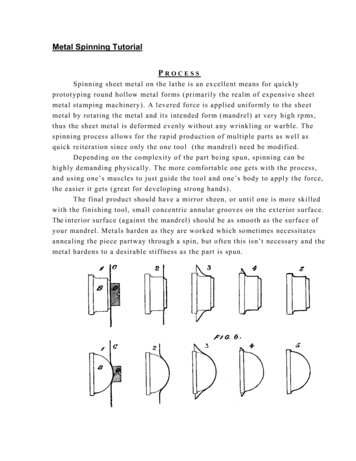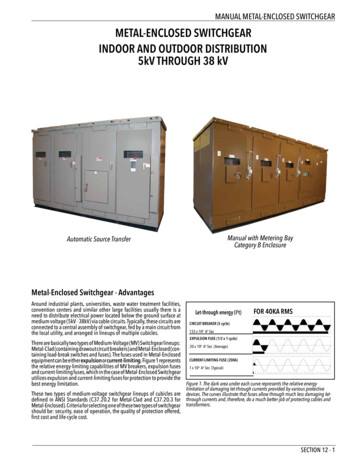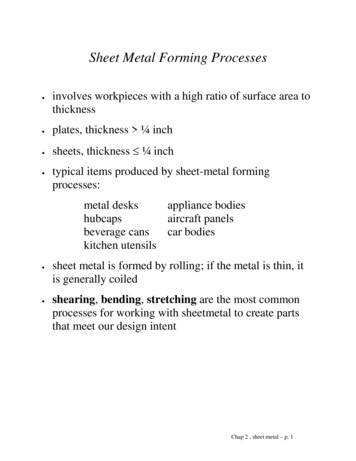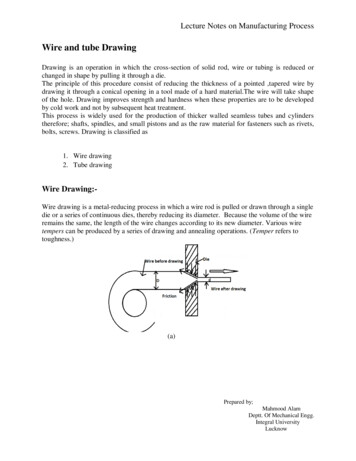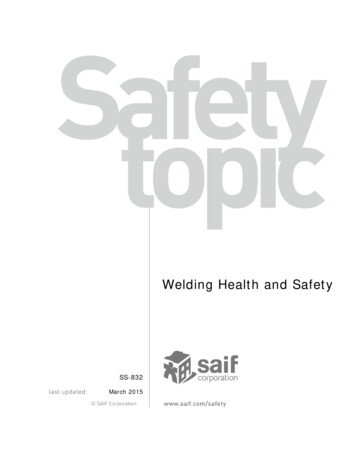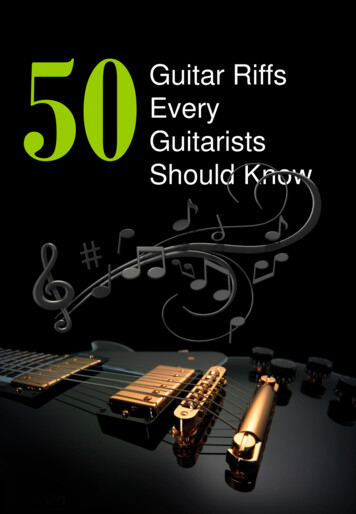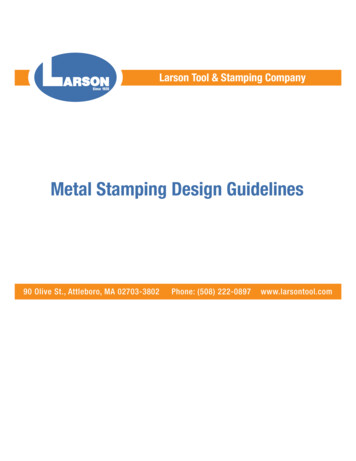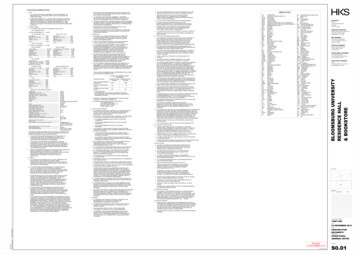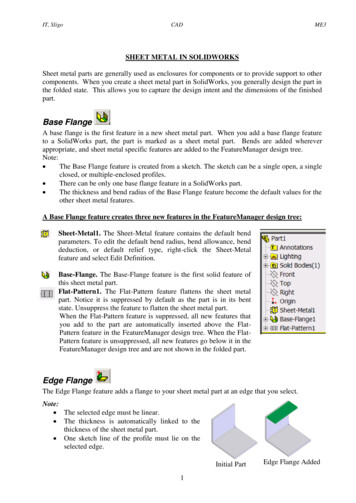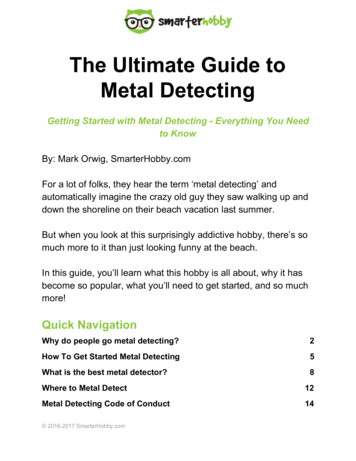
Transcription
The Ultimate Guide toMetal DetectingGetting Started with Metal Detecting - Everything You Needto KnowBy: Mark Orwig, SmarterHobby.comFor a lot of folks, they hear the term ‘metal detecting’ andautomatically imagine the crazy old guy they saw walking up anddown the shoreline on their beach vacation last summer.But when you look at this surprisingly addictive hobby, there’s somuch more to it than just looking funny at the beach.In this guide, you’ll learn what this hobby is all about, why it hasbecome so popular, what you’ll need to get started, and so muchmore!Quick NavigationWhy do people go metal detecting?2How To Get Started Metal Detecting5What is the best metal detector?8Where to Metal Detect12Metal Detecting Code of Conduct14 2016-2017 SmarterHobby.com
ResearchOld MapsLocal history booksOld newspapersState-specific treasure guidesLandowners151619192121Getting Permission to Metal Detect23How to Dig Responsibly5 Steps to Digging the Perfect Plug2426How to Carry Your Finds27How to Clean Your Finds29Tools and AccessoriesPinpointersDiggersHeadphonesCoil Covers (Scuffs)Pouches/Carry Bags/BackpacksExtra CoilsGearOdds and ends / safety303133343536373839Metal Detecting Magazines40Have Fun!41Why do people go metal detecting?Let’s start off with a simple question: why do people go metaldetecting, and what’s so exciting about it? 2016-2017 SmarterHobby.com
As someone who loves this hobby and actively detects, this issuch a hard question to answer because there’s so much to say.The first thing to understand is that different people have differentreasons to detect. Here are just a few more of the commonreasons: The love of history and thrill of being able to hold somethingin your hands that hasn't seen the light of day in hundreds ofyears. The love of coin collecting. Whether that be older colonialsilver coins or more modern coins like wheat pennies. The love of being active and in the outdoors. Believe it ornot, metal detecting can be a fantastic form of exercise. And of course financial gain from either selling your finds(gold/silver jewelry) or even gold nuggets.Personally, my interests lie in the first three categories - as domost metal detectorists I know.In fact, very few people I know are in this hobby for financial gain.Their finds are often more meaningful to them than a few extradollars in their pockets.Contrary to what a lot of people may think, people who metaldetect are often history buffs and collectors who don’t frequent thepawn shops. 2016-2017 SmarterHobby.com
Metal detecting can also be extremely addicting - especially whenyou find yourself digging up relics that are hundreds of years old.One of my very first finds was a French Military button from thelate 1700s. I dug it near an old colonial homestead that, throughresearch, I determined was once owned by a French familyhundreds of years ago.Pulling items like that out of the dirt gives you a huge adrenalinerush. For me, this is my ‘why’ for metal detecting. 2016-2017 SmarterHobby.com
How To Get Started Metal DetectingIf my above personal account has your mouth watering, let’s talkabout how you can get started in this beautiful hobby.First, let’s briefly talk about the type of equipment you’ll need,then we’ll talk about places to hunt and research. Later in thisguide, I go into depth on each of these topics.There is so much equipment you can choose to utilize to makeyour hunts more productive, but let me simplify it for you.When you’re first starting out and not sure if you’ll even like thehobby (or if budget is a concern), you’ll want to get yourself anentry level detector.That’s really all you need to start. Some folks will say you need a‘pinpointer’, extra coils, diggers, pouches, carry bags, scoops,covers, gloves, towels, probes, etc.The amount of equipment is endless. While those things are allvery useful for the experienced hunter, when you’re first startingout all you really need is a detector.After all, you don’t want to be spending loads of money up front ifyou’re not sure you’ll like the hobby. We’ll talk more aboutaccessories later in this article, but for now, let’s stick to entrylevel detectors. 2016-2017 SmarterHobby.com
At the time of writing this guide, a quality entry level metaldetector will cost you anywhere from 160 to 400.Anything over 400 I consider to be midlevel.Just to put this price into context, some detectors can cost up to 10,000.Yes, 10k.But machines that cost this much are meant for gold prospectingin areas where there’s known gold in the ground like on old claims(see our post on gold panning kits).For detectors that are more all-round machines, the maximumyou’re going to pay at the moment is about 2,500 - and that’s forthe most advanced technology will all the bells and whistles.The brands you want to look at when choosing any level ofdetector are: Garrett (most popular with beginners)FisherTeknetics (same company as Fisher)Minelab (most advanced technology)Tesoro (older, classic-style machines)Whites 2016-2017 SmarterHobby.com
Click here to read my post on the b est metal detectors forbeginners or here for the b est detectors for kid s. A lot of folks will go with the Bounty Hunter brand when firststarting out because they’re so cheap and can be found at storeslike Walmart .But quite honestly these machines are very low quality and won’tgive you a great experience.For a few extra bucks, you can get a detector that’s so muchbetter. And what’s great about this hobby is that most of theequipment holds it’s value like you can’t believe.So worse case scenario you don’t like the hobby, just put yourdetector on ebay and get (most) of your money back.So what entry level machine should you get?Here all the most popular entry level models currently availablefor each of the brands I mentioned above: G arrett ACE 300 (formerly known as the ACE 250)F isher F2 2 (my complete review here )Teknetics Eurotek ProMinelab X-terra 305Tesoro Compadre 2016-2017 SmarterHobby.com
These are all entry level machines. To get an idea of what'sconsidered to be a mid-level machine, take a look at the G arrettAT Pro .Yes, there are cheaper models available in most of these brands,but these will give you the most bang for your buck.You really can’t go wrong with any of the above machines whenyou’re first starting out.What is the best metal detector?Ok so all entry-level selection aside, let’s talk about what is thebest metal detector.Quite honestly, there is no best detector.A lot of people think certain machines will find better stuff or getbetter depth.And yes this can happen if we’re comparing a 100 machine witha 2,500 machine in neutral ground.But for the most part, the ‘best’ metal detector is (sort of) a trickquestion.The better question would be, what is the best metal detector forme? 2016-2017 SmarterHobby.com
Because the ‘me’ part of that question has a lot of variables suchas: Where do you live - meaning what part of the country (orwhat country in the world for that matter)? What type of hunting do you want to do (coin, relic, beach,gold, etc)? More on this later. What's your budget? What's your experience level with metal detecting? How tech-savvy are you?For simplicity sake, I am going to tell you that all metal detectorsdo the exact same thing - detect metal.What makes certain machines more expensive than the others isthe additional features and different technologies.It’s really that simple.If I put a silver coin in front of you and hand you both a 100machine and a 2,500 machine, they’re both going to tell youthere’s a silver coin in front of you and that you best pick it up.Now let’s say I also put an old rusty nail next to that coin. 2016-2017 SmarterHobby.com
The 100 machine will detect metal, but it won’t be sure what thetarget is. 2016-2017 SmarterHobby.com
The 2,500 machine will go so far as to tell you there are twotargets in front of you, one that is a coin and one that is trash.That is just one example of how the entry level machines differfrom the more expensive ones.Make sense? Good.We’ll talk much more about the technology behind metal detectorsin future articles. Since this is an introductory guide, I don’t wantto bore you with too much more techy stuff.So that’s all you really need to know regarding selecting an entrylevel detector. You can’t go wrong with any of the ones Imentioned above so take your pick and get out there!I’ll go into more depth on accessories later in this article, so let’scontinue with some other things you need to know to get started.Use this guide to learn how to choose the best metal detector foryour needs.Learn more about the best metal detector specifically for coinshere . One final point to make is that there is a huge market out there forused metal detectors . So if your budget is a bit tight but you don'twant to settle for a lesser machine, consider buying used. 2016-2017 SmarterHobby.com
Where to Metal DetectThe most common places to hunt are going to be: Public schoolsPublic ParksBeachesWoodsPrivate PropertyBefore I go any further on this topic, I want to mention that youalways need to be 100% sure that you are permitted to huntwhere you want to hunt.Hunting places without permission is a huge no-no in this hobby.And even though a place is a public property, you still need to becertain that you're allowed to detect there.For example, many public parks strictly prohibit metal detecting especially parks run by the county and state. And you can prettymuch assume that Federal Parks are off limits too.So always check with your local government before stepping footon public land with your metal detector.When it comes to public schools, the same thing applies really.Get permission. 2016-2017 SmarterHobby.com
What I like to do is contact the Superintendent of the schooldistrict to get permission. This way I have permission for everyschool in that district.When hunting in the woods on public land, be sure to keep an eyeout for signs posted and/or property lines. It’s not that hard towander off into someone’s private land when you think you’re stillon public lands.Beaches are usually fair game - but again look for signs. Also,some beaches are privately owned or owned by State/Federalgovernments. These are almost always off limits.Lastly, let’s talk about private property. Hunting on privateproperty will be the best ground by far for a few reasons. First, you can almost guarantee that no one else has everdetected there (as opposed to a public park or schoolyard). Second, the landowner can give you clues where to startyour hunt. Maybe they noticed some broken pottery out inthe woods in one spot of their land years ago. That would bean excellent place to start your hunt!I cannot stress enough the importance of getting permission.While verbal permission will often suffice for private land, I alwaysget written permission for any public or government-owned land.Take the written permission (whether it’s a letter or an email printout) and keep it with you at all times during your hunt. This way if 2016-2017 SmarterHobby.com
you’re ever approached by someone, you have proof that you’reallowed to be there.Once you secure permission to hunt the land, let’s talk about yourcode of conduct.Metal Detecting Code of Conduct I will respect private and public property, all historical andarchaeological sites and will do no metal detecting on theselands without proper permission. I will keep informed on and obey all local and nationallegislation relating to the discovery and reporting of foundtreasures. I will aid law enforcement officials whenever possible. I will cause no willful damage to property of any kind,including fences, signs, and buildings. I will always fill the holes I dig. I will not destroy property, buildings or the remains ofdeserted structures. I will not leave litter or other discarded junk items lyingaround. I will carry all rubbish and dug targets with me when I leaveeach search area. I will observe the Golden Rule, using good outdoor mannersand conducting myself at all times in a manner which willadd to the stature and public image of all people engaged inthe field of metal detection. 2016-2017 SmarterHobby.com
It’s so important to read and follow the code of conduct in it’sentirety. If not, you risk being able to metal detect in the future.Landowners and government officials will no longer grantpermission for you or others to metal detect if you’re leavingunfilled holes behind and otherwise treating the land irresponsibly.The thing to remember is that wherever you’re hunting, you mustleave that place looking exactly as it did before you got there - orbetter!Now that we’ve talked about some possible places to detect, let’stalk about doing research to make your site selection a bit moreeffective.ResearchWhile I could probably write an entire book on how to doproductive research, this guide is going to touch on the basicsand focus primarily on private land.Before getting into specific sources, let’s first identify why it’simportant to do research.While the most important part of this hobby is just to have fun andenjoy yourself, it never hurts to create more productive hunts foryourself and walk away with better finds. 2016-2017 SmarterHobby.com
So instead of finding 87 cents in modern clad coinage in your twohour hunt, you could potentially walk away with coins and relicsthat are hundreds of years older.Here are a few ways to conduct research:Old MapsArguably the best method of doing research, looking at old mapsof your town can give you tons of ideas on where to hunt. 2016-2017 SmarterHobby.com
It also can be the catalyst for a more granular form of researchsuch as searching old newspapers for specific family names.Depending on where you live, there’s an online tool available tothe public that’s awesome for comparing old maps with presentday maps.It’s a website called HistoricAerials.com .You can type in any address and quickly view overlays of oldmaps. So for example, I can view a present day map of myhouse, and overlay a map from 1930 to compare how the areahas changed over time.What this allows you to do is to identify quickly things that nolonger exist. If there once stood an old house in the woods nearyour house or point of interest, this tool can potentially tell youthat.This is an extremely effective way to find lost and forgottenhomesteads and other structures.I’ve done it many times with great success. Remember theFrench military button I told you about earlier in this guide?The only limitation of HistoricAerials.com is that is doesn't havedata for the entire county, and the data it does have will typicallyonly go back about 100 years maximum. 2016-2017 SmarterHobby.com
But if a house that was built in the 1700s was still standing in1930, you should be able to spot it (as I have).You can also quite easily find much older maps of your town orareas of interest from both online map collections, your locallibrary, and your local historical societies.Here are some great online map resources comAncestry.comAs I mentioned above, your local library will often have invaluableresources to look at. Everything from old maps to old periodicalsand microfilm can be found at your local library.A lot of times this material will be in a special room under lock andkey. But simply ask your librarian and they’ll be happy to grantyou access.The same is true with local historical societies. These can oftenbe even more effective sources of information because the peopleworking there can be a major asset to you. 2016-2017 SmarterHobby.com
And who knows, you may even find yourself making new friendsand becoming a member of the society!Local history booksStaying on the topic of local historical societies, this can be yourfirst stop for finding local history books.Whether published by the society themselves, or self-publishedby a local historian, your local historical society can be a greatsource of lesser known books.Beyond this, I would recommend doing some Google searches forhistorical books on your town. The ‘Images of America’ bookseries is very popular and can be found at most bookstores aswell as Amazon.com.Old newspapersIn addition to the old newspapers you came across on your trip tothe local library, there are two other massive repositories toconsider.The first is Newspapers.com . This is a paid tool that’s owned bythe same company who owns the popular Ancestry.com .The great thing about this site is that you can do keywordsearches to narrow down what you’re looking for. Whether you 2016-2017 SmarterHobby.com
want to find mentions of a certain family, place, or event, chancesare you’ll be able to find it there.The only real limitation of this source is that it currently only haslarger newspapers in its database (for larger cities).So if you’re searching for something that’s super local or superniche, you may not have any luck.The other, more well-known source to consider is microfilm.Most county and state libraries will have a vast collection ofmicrofilm to scroll through. You can even check to see if yournearby University Library has some to offer.If you really want to get down and dirty with your newspaperresearch, ask your local librarian about a service called“Interlibrary loan.”In a nutshell, for a small fee your local library can ‘rent’ a specificreel of microfilm from other libraries and repositories anywhere inthe country.This can be a huge time saver as it prevents you from having totravel long distances to visit libraries who have specific films.It does, however, require you to do a bit of research first todetermine which reels of microfilms you want to rent (i.e. specificdates and newspapers). 2016-2017 SmarterHobby.com
State-specific treasure guidesAnother way for finding great spots to detect in your area is to buya ‘treasure book’ for your state or area.You can find these at your local metal detecting shop or onamazon.But essentially these books include things like historical sites andevents, local folklore, old maps, known military battle sites/campgrounds / marching routes, and more.While these books can pack a ton of great information, most ofthe information isn’t practical because a lot of the sites will be offlimits and require special permission or a permit. But theycertainly are entertaining!LandownersLast but not least, an often overlooked strategy for research istalking to the older members of your community as well aslandowners of older homes/property.A lot of people who like to hunt for Revolutionary and CivilWar-era relics often ignore this suggestion because they figure,hey how is someone who was born in 1932 going to help me? 2016-2017 SmarterHobby.com
What I say to that is just because someone was born in 1932,doesn’t mean they don’t remember something from theirchildhood that once existed - a building, a home or any structurethat no longer stands today.Sometimes first-hand accounts can give us some of the bestclues to discovering an old homestead that we would have neverfound otherwise.As I mentioned above, a lot of times landowners (especially thosewho have several acres) might remember things that could guideyour hunting. Like the example I gave with a landowner diggingup old broken pottery on one section of his/her land.I’ve seen some colonial homeowners have brief histories of thehome and land that’s been passed down from one homeowner tothe next. This can provide invaluable clues and help you laserfocus your detecting area.While there so many more forms of research you can do, theseare often the most effective and easiest to conduct.Now that you’ve hopefully found some stellar areas to detect, let’stalk about getting permission! 2016-2017 SmarterHobby.com
Getting Permission to Metal DetectFor whatever reason, this seems to be one of the most commonobstacles to getting access to great detecting spots.Many people get nervous or feel silly knocking on someone’s doorto ask for permission.And understandably so in some cases.Let's face it, metal detecting is not super common in certain areasof the country, and people living in those areas might not haveany idea what you’re talking about.Likewise in areas that are more suburban and full of beautiful,well-kept green lawns, a lot of people might tell you to bugger off.After all, they’ve spent so much time and money on their lawnsand don’t want you coming in to dig it up.While this can be a dealbreaker for a lot of homes, it cansometimes help to show the homeowner how exactly you digsmall plugs for targets and explain your process of only digginggood signals.Because if you remember from our metal detecting code of ethics,you’re going to leave the property exactly as you found it. You justhave to convey that to the homeowner. 2016-2017 SmarterHobby.com
If you don’t feel comfortable knocking on someone’s door to start,some alternatives are to send them a letter, drop a flyer/businesscard in their mailbox, or even call them on the phone.Either way, just be honest and straightforward with them.The deal that is most often made between the detectorist andhomeowner is that the detectorist keeps everything they findunless the homeowner specifically asks to keep something.The detectorist is also obliged to return any lost items, jewelry,and family heirlooms to the property owner. This is also just goodethics.Now that you’ve got permission and access to a great property,here are some tips to digging responsibly.How to Dig ResponsiblyAs a rule of thumb, a hand digger should be used on propertiesthat are less than two acres. Anything over that you can start tothink about a mid-sized digger for faster digging.The hand digger tool of choice for most detectorists is the Leschedigging tool . 2016-2017 SmarterHobby.com
This tool can sometimes be referred to as a digging knife.The digger is serrated on one side for easy digging and cuttingthrough roots.Typically if you’re right handed, you’ll want the version that isserrated on the right side. Likewise, lefties will want serrations ofthe left side. Here’s why:When you dig for a target, you want to dig what they call a ‘plug.’Learning to dig a plug is a must for detecting on well-manicuredlawns, as well as public parks and schoolyards. 2016-2017 SmarterHobby.com
While it’s much easier to demonstrate visually, I’ll try my best toexplain exactly how to do this:5 Steps to Digging the Perfect Plug1. When you come across and pinpoint a target that you wantto dig, take out your hand digger and get down on yourknees. From the exact spot your target is, back off about3-5” and stick your digger in the ground.2. In a counter-clockwise motion, start cutting away at thegrass sod until you’ve formed a horseshoe-like shapearound your target (you’re not cutting a complete circle).When cutting into the grass, be sure to go down a minimumof 3” (even if your target it only 1”). This will ensure you’renot killing any of the grass roots.3. Once you’ve cut around your target, use your digger to pryopen and flip the plug onto it’s head. Remember you cut theplug in a horseshoe shape so the part that you did not cutwill now act as a hinge to flip open your plug. The grass ofthe plug should now be completely upside down on top ofthe grass adjacent to the hole.4. Take out your towel (I like to use a 1x2’ towel) and lay itdown in the grass directly in front of the hole. If you don’t seeyour target right away, use your handheld pinpointer to firstcheck the plug, then the hole. If you need to dig away 2016-2017 SmarterHobby.com
additional dirt from either the plug or the hole, put it on yourtowel.5. Once you’ve recovered your target, lift up both ends of yourtowel and slide any dirt back into the hole. Flip your plugback over and press down firmly. Step on it with your foot afew times to make sure it’s in there good. Use your hand tobrush the grass so it’s not matted down.Like I said, easier to demonstrate visually than to write out.This may seem like overkill for some, but taking care of the landyou’re detecting is imperative and part of the code of ethics.So take it seriously.Now that you’ve dug your target let’s talk about what to do withyour finds.How to Carry Your FindsSo let’s talk about what to do with your finds to keep them safeduring the rest of your hunt.If you remember from the metal detecting code of ethics, we willalso be disposing of trash responsibly when we detect. And thechances are good that you’re going to have a lot of trash. 2016-2017 SmarterHobby.com
That’s why you need a belt pouch that has at least two pockets one for your good stuff and one for your trash. This makesdisposing the trash at the end of your hunt much easier.Now, what if you were to find something really nice like say asilver Morgan dollar or a diamond ring?You probably don't want to just throw it in with the rest of yourfinds because it could very well become damaged.What I recommend is that you also carry with you (usually in yourcarry bag, not your pouch) a special plastic case stuffed withcotton balls. 2016-2017 SmarterHobby.com
I just use an old fishing tackle case. Doesn’t have to be fancy.You just want something that you can transport valuable findswithout getting damaged.Ok now that you’ve successfully protected your finds, let’s talkabout how to clean them.How to Clean Your FindsThe most important thing you need to know about cleaning yourfinds is that you must be absolutely certain what the find is andwhat (if anything) it’s worth. This mainly applies to coins.The reason for this is that if you do plan on selling your find, youcould actually ruin the value just by cleaning it. Serious coincollectors consider coins that are cleaned to be damaged.Because I don’t intend on selling any of my finds (unless it’swomen’s jewelry that my wife doesn’t want) I don’t really concernmyself with this.I actually carry a soft bristled toothbrush in my pouch so I can dosome light cleaning in the field when I'm having trouble identifyinga find. 2016-2017 SmarterHobby.com
In terms of cleaning while you’re home, well you probably want tostick with a soft bristled toothbrush, warm water, and dish soap.Avoid strong chemicals as these can eat away at the metal.For seriously crusted iron relics, many people opt for a procedurecalled electrolysis. This is not for an entry level guide, but I maygo into the process in future articles.Another way people clean their finds (especially things of lowvalue like wheat pennies) is to use a rock tumbler. Again I willcreate an entirely separate article on this topic in the future.Just to be crystal clear, never clean any of your finds if you’re notsure of the value, and there’s even the smallest possibility youmay want to sell it. It could seriously ruin the value - especiallywith rare coins.Now that you’ve cleaned up (or not) your finds for the day, you’reprobably thinking to yourself, this hobby rocks!If that’s the case, then it’s time to look at some other tools andaccessories to make your detecting more productive.Tools and AccessoriesWhen you’re first starting out, a lot of the accessories you use canbe things you have laying around the house like an old fannypack, tool belt, backpack, digger, gloves, etc. 2016-2017 SmarterHobby.com
But if there’s one single accessory you should buy, it has to be aquality pinpointer.PinpointersWhat is a pinpointer?A pinpointer is a small, handheld metal detector that does exactlywhat it’s called - pinpoints your target.So while your normal metal detector will pinpoint a target to withina few inches, a separate pinpointer will tell you the exact locationin the hole or plug.The way to use a pinpointer is after you dig your plug, take yourpinpointer and stick it in the hole. Once you get within a fewinches of the find, your pinpointer will start to beep (or vibrate). 2016-2017 SmarterHobby.com
Why are pinpointers so valuable and do you really need one?Simply put, they allow you to recover your targets 10x faster andeasier which means you’ll be able to spend more time detecting,and less time digging.And more time detecting means more finds at the end of the day.It’s as simple as that.But hey, don’t take my word for it. Go out on a few hunts withoutusing a pinpointer and tell me how much time it took you torecover your target after digging your plug βWhat the best pinpointer? ( click here to see my top five picks).While there’s not a huge amount of debate about this (althoughsome folks have their preferences) the best pinpointer is theGarrett Pro Pointer AT .If you’re strapped for cash, you can also get the little brother tothis model that’s called the Garrett Pro Pointer II.Let’s talk about some other equipment you may want to considerif you’re serious about getting into this hobby and making yourhunts much more productive. 2016-2017 SmarterHobby.com
DiggersI won’t go too much into the various types of diggers, but here aremy recommendations: Public parks, schools, private lawns: use a small handdigger. I recommend the L e sche digging tool. Woods, farm fields, large properties without manicuredlawns: use a mid-level digger like the Lesche Sampson,Relic Hunter or Ground Sharks. Beaches: use a sand scoop. Don’t bother with plastic unlessyou want it to break the first time you use it. And speaking ofbreaking, don’t use a hand held scoop unless you want tobreak your back. A hand held scoop is fine if you’re justplaying around at the beach on vacation with your kids, butserious beach hunters use long handled scoops. Rocky areas: use a hand pick along with a hand digger. Rivers: if you’re relic hunting, use a hand pick that has apowerful magnet attached to the butt of the handle. This willallow you to easily pick up ferrous, magnetic targets
Local history books 19 Old newspapers 19 State-specific trea sure gui des 21 Landowners 21 Getting Permission to Metal Detect 23 How to Dig Responsibly 24 5 Steps to Diggin g t he Pe rf ect Pl ug 26 How to Carry Your Finds 27 How to Clean Your Finds 29 Tools a

